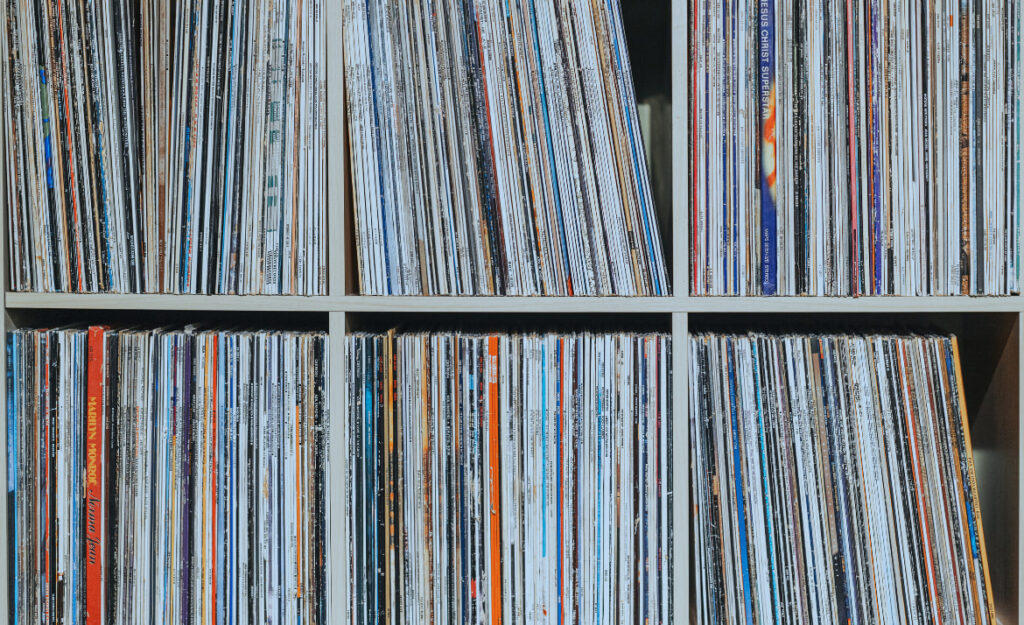
Storing records can feel like a puzzle. Finding a dust free vinyl storage solution is key to preserving sound quality. Clean storage pays off every time you set the needle down.
Vinyl enthusiasts know that careless handling or poor storage leads to scratches and static. Dust particles cling to grooves, creating pops—subtle at first, but they grow with every play. Clean storage matters more than many realize.
Whether your shelf holds ten records or a thousand, protecting them saves time and money. Let’s explore smart, realistic steps for dust free vinyl storage that keep every record as perfect as the day you bought it.
Choosing Storage Locations for Maximum Dust Protection
The right spot for your records protects them from dust and other airborne threats. Start by scouting your space and noting airflow, sunlight, and traffic near your shelves.
Main living areas usually expose vinyl to less dust than basements or garages. Avoid rooms with open windows, ongoing renovations, or pets passing by—dust accumulates fast in these conditions.
Using Elevation to Reduce Settling Dust
Place record shelves at least 12 inches above the floor. Lower shelving invites dust kicked up by walking, vacuuming, or opening doors. Raising your storage breaks the direct path of everyday grime and debris.
Collectors sometimes joke that “bottom shelf” is code for “trouble”—and not just for forgotten albums. Bookshelves set above knee height shield records from dust built up on floors.
Include records in open shelving units, but opt for enclosed ones if traffic or cleaning in that area is frequent. Quickly dust the top of each unit weekly as a workaround.
Limiting Air Movement and Drafts
Place vinyl away from heat vents, fans, doors, and windows. Strong airflow spreads dust throughout the room and pushes particles directly onto records and sleeves. Still air means cleaner albums.
In a living room, tuck record shelves away from the main path but ensure plenty of clearance for browsing. Draft stoppers or curtains help block recirculating dust if vents are unavoidable.
If you store vinyl in spaces with forced-air heating, check air filters monthly. Swapping out dirty filters improves air quality and prevents fresh dust from settling on your collection.
| Storage Location | Dust Exposure | Air Movement | Best Practice |
|---|---|---|---|
| Living Room (closed shelving) | Low | Minimal | Ideal for dust free vinyl storage |
| Bedroom (open shelves) | Moderate | Mild drafts | Use covers, dust weekly |
| Basement (no dehumidifier) | High | Unaired | Avoid for valuable vinyl |
| Garage or Attic | Very High | Fluctuates | Not recommended |
| Corner with window nearby | Moderate | Variable | Add blackout curtains, close windows |
Inner and Outer Sleeves: The First Defense
Installing the right sleeves around each record provides a hands-on way to achieve dust free vinyl storage. Think of sleeves as armor, keeping debris and static at bay.
Quality inner sleeves made from anti-static polyethylene prevent dust from clinging to delicate grooves. Outer sleeves with resealable flaps create an easy second barrier against outside particles and fingerprints.
Upgrading to Premium Sleeve Materials
Upgrade paper sleeves to plastic-lined or full-poly sleeves. Paper creates friction and leaves fine debris. Copy a collector’s tip: slip a rice-paper sleeve inside the jacket and rotate halfway on each new play.
- Switch inner sleeves to anti-static polyethylene; static charges draw dust and harm sound.
- Insert outer sleeves with resealable tops; keep air and dust out longer.
- Avoid PVC outer sleeves; these can off-gas and damage vinyl over time.
- Store records vertically, never stacked; weight and friction worsen dust-related damage.
- Add a quick visual scan each time you file an album; sleeves with splits or gaps need replacing to preserve dust free vinyl storage.
Sleeves with rounded openings slip in easily and reduce handling time. Fast handling means records spend less time exposed to airborne dust or oils from fingertips.
Labeling Sleeves Without Compromising Protection
Use removable labeling tabs on sleeves instead of permanent stickers. Markers or direct labels can degrade plastics and let in fine particles over time, harming dust free vinyl storage.
- Choose acid-free, removable tags for identifying special editions; reposition without leaving residue.
- Opt for colored sleeves for genres; make selection fast, so jackets stay closed and dust-free longer.
- Write catalog numbers on the outer, not inner, sleeve for clarity and safety.
- Align sleeve notches with record jacket openings; easy removal reduces accidental tussles with dust-laden air.
- Keep a spare box of new, unused sleeves handy; replace worn or torn ones without delay for year-round dust free vinyl storage.
The right sleeve strategy balances access and protection. Make each bag or slip count, and your record collection stays pristine.
Enclosures and Cabinets for Extra Security
Sturdy cabinets with doors deliver dust free vinyl storage and reduce daily cleaning. Their sealed walls and simple hardware keep light, air, and particles away from records for months at a time.
Look for storage furniture that holds records upright, leaving space for airflow behind each album. It’s a pattern that mimics professional archival shelving.
Keys to Safe, Nonreactive Shelving Surfaces
Design shelves from wood, metal, or sealed MDF. Bare particle board may off-gas or break down, collecting more dust. Avoid glass panels or open-topped display cubes for long-term storage.
Ask retailers if a cabinet’s shelves are weight-rated for vinyl. Each album is heavier than its size suggests—16 records may weigh over ten pounds. Write “supports at least 30 lbs per row” on your checklist.
Always wipe new storage surfaces with a lint-free cloth before use. Subtle residue from manufacturing draws dust, so a fresh wipe gives your vinyl a clean start, ensuring full dust free vinyl storage.
Creating Airflow While Blocking Dust
Install cabinet doors with soft-close hinges. The gentler the closure, the less dust stirs up. Add or swap standard furniture gaskets for finer weatherstripping to form tight, dust-blocking seals behind every door.
If humidity worries you, drill small ventilation holes near the back panel. Cover these with fine mesh to block dust while encouraging mild air circulation, a trick archives use for dust free vinyl storage.
Avoid displaying records in cubbies with open backs that face exterior walls. Airborne pollen or soil particles invade silently in these setups. Enclosure provides the edge when every groove counts.
Routine Dust-Free Habits for Every Collector
Following a predictable daily or weekly routine keeps dust free vinyl storage simple and consistent. The difference shows with each quiet listen—even years after purchase.
Store a microfiber duster on the same shelf as your albums. It signals you to quickly wipe surfaces before and after pulling albums, anchoring the habit right where you need it.
Hands-on Cleaning Without Residue
Always wipe shelves—both above and below records—in one direction, not back and forth. Move slowly, let the duster pick up particles, and avoid stirring them onto jackets or floors.
Allocate five minutes every Sunday to inspect sleeves, jackets, and shelf corners. If you spot a layer of dust along the edges, adapt your schedule. Five focused minutes can keep hundreds of records dust free.
If nearby electronics or speakers attract dust, unplug and clean those surfaces monthly. Look for static-prone objects nearby and keep record storage away from them to reduce dust transfer.
Shelves as a Visual Anchor for Cleanliness
Position your best-looking albums forward to act as a reminder. Seeing pristine covers as you walk by nudges you to care for the rest, a small psychological advantage.
Use a sticky lint roller every month along the shelf edges if you have pets. The hair and dander cling where sleeves and record jackets rest, so fast removal keeps interiors dust free.
Avoid stacking anything on top of records, even for a day. Miscellaneous items shed lint or debris, undoing weeks of effort for dust free vinyl storage. Make an “always clear” zone policy stick with a simple rule—nothing on record shelves except vinyl.
Storage Accessories That Step Up Protection
Adding the right accessories to your dust free vinyl storage can make practical improvement feel easy. Small upgrades deliver noticeable changes in record condition, even in busy homes.
Start with protective covers, gentle brushes, or antistatic mats—items that integrate smoothly into your daily browsing routine.
Tools That Exemplify Efficiency
Display-handling gloves prevent smudges as you browse. Microfiber cloths designed for LPs offer an all-purpose dust shield. Keep a carbon-fiber brush at hand for last-minute cleaning before each play—think of it as a toothbrush for audio clarity.
Record cleaning machines, whether manual or electric, handle thorough dust removal when sleeves alone can’t keep up. They fit neatly beside shelving and take five minutes per record for complete dust free vinyl storage.
Buy or DIY dividers to improve airflow between albums. For every dozen records crowded tightly together, slip a thin divider in; it reminds you to keep things loose, so dust doesn’t trap between jackets.
Upgrade Your Workspace’s Cleanliness
Never forget the table or stand where you set albums before or after playing. Wiping these daily with the same microfiber used for jackets keeps transferred dust from sneaking back into storage.
Construct a quick cleaning station: one shelf with fresh cloths, record cleaning fluid, and your go-to brush. Write “clean, then shelve” on a sticky note to enforce your new workflow and maintain dust free vinyl storage.
If you plan to show off records on display stands, dust both stand and album face every morning. Turn records at different angles weekly to reveal and catch accumulating dust early—before it reaches the grooves.
Modern Display Ideas That Prevent Dust Exposure
Stylish display storage can look great while keeping every inch of surface dust free. Mix display and protection strategies to showcase your favorites with confidence and safety.
Wall-mounted racks with acrylic shields let you view jacket art without worrying about airborne particles. Cover them with magnetic doors if you access records frequently, making dust free vinyl storage a visible habit.
Custom Shelving and Creative Visibility
Ask a carpenter to build fitted shelving using cabinet-grade birch plywood. Add smoked plexiglass doors (with finger pulls) to control light and dust. Request tight tolerances—”leave no more than five millimeters of air gap”—to minimize dust invasion.
Arrange your records with color-coded spine markers for quick access, reducing time covers must be open. Practice closing all doors and cases after retrieving an album—make it automatic.
Mix favorites into wall displays using shallow ledges under clear cases. Snap close or magnet-seal after placing an album, making sure to wipe the inside of each cover every two weeks for top dust free vinyl storage.
Lighting Choices and Dust Awareness
Install indirect, LED lighting above or behind display shelving to attract less dust than bulbs placed directly overhead. Warm LEDs stir less heat than halogens or incandescents.
Keep adjustable task lamps at a safe distance, so air movement stirs less debris. Add flexible gooseneck lamps for browsing, aiming the beam away from exposed jackets when opening doors.
Position light sensors or small sticky notes to signal cleaning days—“dust check Fridays.” This keeps cleaning habits tied to physical cues, improving the longevity of dust free vinyl storage habits.
Careful Handling Prevents Recontamination
Handling records with intention locks in all the efforts you’ve made to achieve dust free vinyl storage. Create a sequence for picking up, airing, cleaning, and replacing each album to maintain pristine condition.
Practice holding records by the edges and the center label. This avoids transferring hand oils and dust to the playing surface, cutting play-related buildup dramatically over time.
Sequential Handling Process
Start by washing your hands every time before touching a record. Pick up the jacket, holding it by the sides, never touching covers with sticky or greasy fingers. Remove the record in one smooth motion.
Finish with a light dusting using a carbon-fiber brush if the record’s surface looks cloudy. Listen for static snaps after play; brush again before sleeving if needed, maintaining full dust free vinyl storage benefits.
Set up a “no food or drink” rule around shelves to deny dust easy entry. Quick reminders—like a refrigerator magnet reading “clean hands, clean sound”—work wonders for families and frequent guests alike.



